#java programming problem.
Text
Ok turns out if you don’t practice your problem solving skills often there is a 100% chance your brain will regress to the state of your 6 year old self and you will forget how to solve the most basic problems.
Good to know.
#I’m not developing anything so I don’t problem solve often#not aiming to be a dev atm#this was so surprising#codeblr#studyblr#coding#programming#code#java#python#javascript#study blog#self study#learning#productivity#sql#progblr#damn I write long sentences btw
332 notes
·
View notes
Text
Me: "okay, I can do this. It's just following simple directions to set up a minecraft server. You can do this. It's going to work. Java isn't that scary."
*get's thrown errors on the very first step*
"Why does Java hate me."
#melon rambles#I swear minecraft mod tutorials never work#java programming stuff never works correctly#I don't know WHAT problem my computer could possibly have#I'm up to date on java and have double checked everything#but it still hates me
2 notes
·
View notes
Text
How to Learn Java Basics for Computer Programming
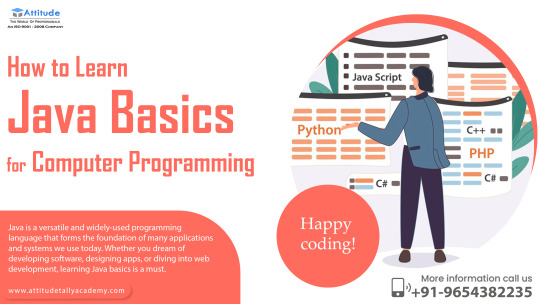
Introduction:
Are you captivated by the boundless world of computer science? Do you harbour aspirations of becoming a skilled programmer? If so, delving into the fundamentals of Java is an indispensable stride toward realizing your ambitions. Java stands as a versatile and extensively utilized programming language, forming the bedrock of myriad applications and systems we rely on today. Whether your aspirations lie in software development, app design, or web development, acquainting yourself with Core Java basics is an essential prerequisite.
Let's embark on a comprehensive journey into the realm of Java programming:
Unlocking the Significance of Java Basics:
Java serves as a gateway to deeper exploration within the realm of computer programming. A firm grasp of Java basics unfurls a plethora of career prospects in software development, web development, mobile app development, and beyond.
Enrolling in a Java Basics Course:
Scour for reputable institutions or training centers offering Java basics courses. Select a course that delves into fundamental concepts such as variables, data types, operators, control flow statements, and the principles of object-oriented programming.
Exploring Core Java Concepts:
Immerse yourself in pivotal concepts including classes, objects, inheritance, polymorphism, encapsulation, and abstraction. Master the art of creating and manipulating objects, defining classes, and implementing inheritance hierarchies.
Hands-On Practice:
Theory alone won't suffice; practice is the cornerstone of mastering Java basics. Regularly code to reinforce your comprehension of concepts. Experiment with bite-sized projects like calculator applications, simple games, or basic utilities to apply newfound knowledge effectively.
Harnessing Online Resources:
Embark on a voyage through online tutorials, forums, and communities dedicated to Java programming. Peruse official Java documentation and resources offered by Oracle for a comprehensive understanding.
Joining Coding Communities:
Engage with peers and seasoned developers in coding communities and forums. Participate in coding challenges, discussions, and collaborative projects to sharpen your skills and expand your knowledge base.
Staying Updated:
The landscape of technology evolves rapidly, and Java evolves in tandem. Stay abreast of the latest updates, trends, and best practices in Java programming. Follow reputable tech blogs, subscribe to newsletters, and partake in webinars or workshops to stay informed.
Seeking Guidance and Mentorship:
Don't shy away from seeking guidance from seasoned professionals or mentors in the field. Reach out to professors, senior students, or professionals entrenched in software development for invaluable advice and insights.
By diligently adhering to these steps, you'll establish a robust foundation in Java basics Guide, paving the path for a gratifying career in computer science. Remember, perseverance and practice are the linchpins of success in programming. Embrace challenges, glean wisdom from setbacks, and perpetually explore the expansive vistas of Java programming. Happy coding!
Suggested Blog:
C++ Development Trends
Java Programming
problem-solving strategies
#problem-solving strategies#Java Programming#C++ Development Trends#Java basics Guide#Core Java basics#computer science
0 notes
Text
Study Hall's Code and Programming for Beginners is out now!
Our friends at Study Hall took on a feat no Complexly channel had done before: teaching coding through YouTube videos. What resulted is a delightful series where we apply programming tools to solve real-world problems like calculating how many lasagnas to bring to a potluck or simulating radioactive mice to stop them from causing world destruction with their poop!
All 28 episodes of Study Hall Code and Programming for Beginners, hosted by Crash Course Kids host Sabrina Cruz, are out now!
47 notes
·
View notes
Text
Custom Disc Installation Guide for Hermitcraft Season 9
I've seen a lot of people struggle with specifically the custom discs, so I made a guide on how to install the mods! It was originally posted as a twitter thread, along with a guide on how to get the world download.
How to install the Custom Discs mod for Decked Out / Hermitcraft 9 world download. Note: I'm assuming you already have the world installed. If you don't know how to do that, you can follow my previous guide here.
1) Follow this link https://oracle.com/java/technologies/downloads/#jdk17-windows…
2) Scroll down and download the "x64 Installer" (or whatever is more convenient for you).

3) Open your Downloads folder and double click - you may need to right click and "Run as Administrator" if it's not working. Then, click Yes and install the program.
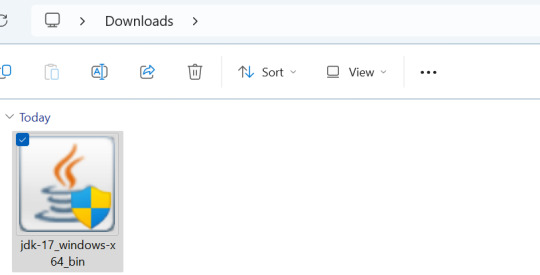
4) The installation software should then open. Just follow the instructions and press Next, Next, and then Close.

5) Open up the Hermitcraft world download. You may have seen the "To play Decked Out as the hermits experienced it..." message in chat. Click on "[Click here]".

6) Press the first link ("Hermitcraft runs on Fabric [link]")
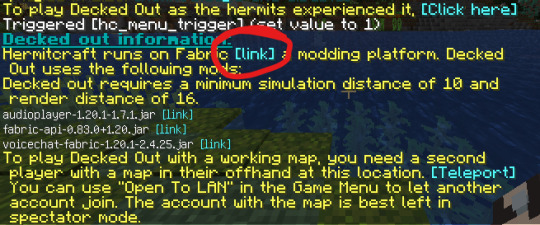
7) Press the download button, then Download for Windows


8) Double click the fabric-installer to open.

9) MAKE SURE THE VERSION IS 1.20! Leave everything else as their defaults. Make sure "Create Profile" is checked. Then, press "Install". - If you can't install, open your normal Minecraft launcher and run 1.20, then close Minecraft.
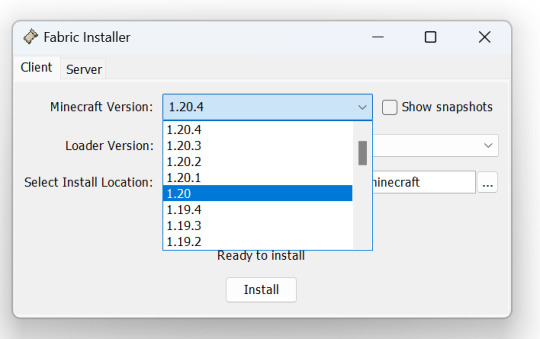
10) Go back to the Hermitcraft world and download the other three mods. Make sure you download all three of them!
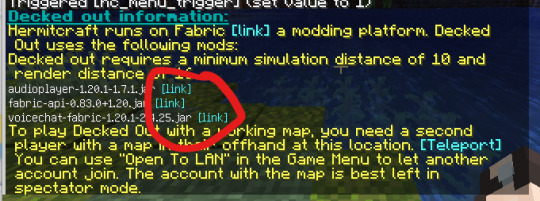
11) Open your Minecraft Launcher and go to Installations. You should see "fabric-loader-1.20". Hover over it and press the folder icon on the right hand side

12) Open the "mods" folder. If you don't have one, create a new folder and name it "mods" (no capitals or punctuation)
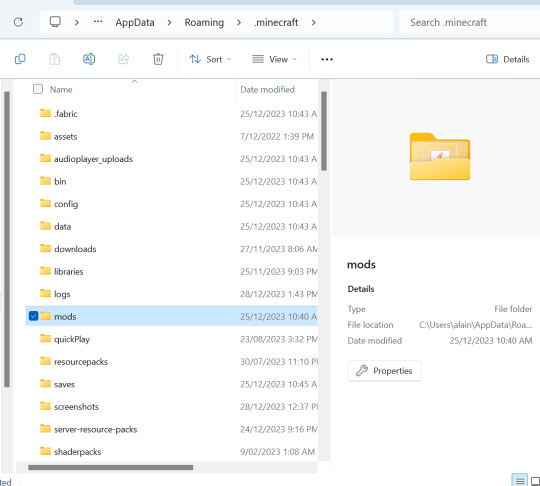
13) Drag and drop the three mods you just downloaded into the "mods" folder.

14) Close Minecraft, and then press "Play" on the Fabric installation

Open Singleplayer, and then your hermitcraft world, and everything should be in working order! To get to Decked Out, you can either visit by the Nether Hub (DO is East/Red 2), or teleport by: /tp -523 103 2171

If you have any issues, feel free to reblog / comment with your problem (with a screenshot of your issue if you have one) and I'll be happy to help.
Good luck, and happy running!
#istg it's an entirely different experience when you get the custom sounds working it's like. amazing#hermitcraft#hermitcraft season 9#hermitcraft world download#decked out 2#scarland#sorry for clogging the tags these are just the two most sound-based experiences i've seen people struggle with#strbylmn posts
43 notes
·
View notes
Note
kind stranger on the internet, if u have the time and it is no inconvenience, a tutorial on how to make the yog world work would be amazing and immensely appreciated T^T
absolutely no problem! i'm here to serve :)
i'm gonna explain this with the assumption you have no idea what you're doing, just so it's thorough.
so, first thing's first, go to the ATLauncher downloads page choose one of the options that's under your operating system (windows, mac, linux) then run the program it gives you. (if it's a setup version, you'll have some stuff to click through but that's pretty easy)
once you've got ATLauncher up and running, you'll want to log in with your minecraft/microsoft account (unsure if it makes you do that at first startup anymore but if it doesn't, it'll be in the Accounts tab) then head over to the Packs tab on the right
go to the search bar and look for Yogscast Complete Pack, it'll be the one with the blue and orange icon, then hit New Instance and Install. it'll come up with a bunch of optional mods, but i personally just select everything except the minimaps and morph
once that's done installing (it might take a while) go over to the Instances tab, and it'll be there. you'll want to mess with it a little bit before opening it, though. there's be a bunch of buttons under the description and that's we're gonna be
you'll definitely want to give it more memory/ram by going to Settings > Java/Minecraft and messing with the very first option. the number you'll want to set it to depends on how beefy your computer is, so make sure you know how much ram it has
after that you'll want to hit Edit Mods and disable Flatsigns, Obsidiplates, and Switches, as the launcher doesn't like to allow them to run anymore
if everything goes right, you'll be ready to import the world save. go to the download link in my (currently) pinned post, save that wherever, and since it's a rar file you may need to have 7zip or winrar to open it but i'm unsure. i personally use 7zip
go back to the ATLauncher and hit Open Folder, that'll open your instance in your file explorer. open the saves folder (or make one if you don't have one yet, 'saves' all lowercase) and extract your world(1).rar into there. you should be left with a folder simply called "world"
go ahead and run the pack and see if everything works!
i have noticed a few other errors that come up, so:
if it's giving you an error along the lines of "two dimensions have the same id," try heading to the config folder (same directory as the saves) and find TwilightForest, open that and scroll down until you see # dimension, then change the number from 7 to 250 (or whatever else works)
if it's giving you an error along the lines of "can't connect to [whatever ip/url]" try editing the config of OpenBlocks and removing all radio stations
if it's something else entirely, try re-running/brute forcing it a couple times then come back and i'll see if i can figure it out
i hope this helps you and anyone else that happens to need it!! don't hesitate to ask for clarification on anything :)
22 notes
·
View notes
Text

When I first started to code, I didn’t really know what’s the real difference between programming and coding. Like, was I coding or was I programming right now? Does HTML count as coding or programming? I would even think a Programmer was this high computer science level that takes years to achieve! Programming and coding are often used interchangeably, but they are not exactly the same thing - let’s talk about it!
At a high level, programming refers to the process of creating and designing computer software or applications. This typically involves writing code, as well as planning and testing the software to ensure it functions correctly. Programming often requires a deep understanding of computer science concepts and the ability to think abstractly and solve complex problems.
Coding, on the other hand, refers specifically to the act of writing code. Code is a set of instructions that a computer can understand and execute. Coding involves writing these instructions using a programming language, such as Java or Python.
Differences
Scope: Programming involves a wider range of activities, including planning, design, and testing, while coding specifically refers to the act of writing code.
Skills: Programming requires a more comprehensive understanding of computer science concepts and the ability to think abstractly and solve complex problems, while coding involves the ability to write code using a specific programming language.
Output: The output of programming is often a finished software product or application, while the output of coding is typically just the code itself.
Similarities
Both programming and coding involve the use of computer languages to create software or applications.
Both require a certain level of technical skill and expertise.
Both are important parts of the software development process.
So, let's quickly summarise: programming involves a wide range of activities, including the planning and design of software, while coding specifically refers to the act of writing code.
Hope this clears up things for anyone confused! And don't worry, even with pure HTML, you're still coding~! Happy coding! 🤎
#codeblr#programming#coding#computer science#comp sci#studying#programmer#learn to code#advice#coding challenge#developer#tech#technology#computer academia#academia#student#studyblr#code study#xc: coding help post#xc: programming blog post
157 notes
·
View notes
Note
uhhhh reverse unpopular opinion about python the programming language. say something nice about it.
okay so I've bitched a lot about bad data science libraries but more common libraries like numpy and scipy are very useful and there are many other decent and well documented python libraries out there. And for the majority of simple programming tasks, it would be absurd to use any other language over python, you're just adding unneeded overhead so that you can work with "bare metal" or something you're familiar with. Along with Jupyter Notebook it's massively simplified the level of effort required to write and run code at all, which definitely shouldn't be discounted either. And almost no other language has the breadth to handle "we're going to do everything we possible can in X language so that you don't need to learn multiple competing standards" in a sane manner without reinventing a thousand things that there's already a library for in python.
And it gets a lot of flak that's entirely unfair as a result of it being popular, similar to how e.g. everyone knows someone who bought a Samsung appliance that sucked shit because far more people own Samsung appliances than other brands. Most people have the problems they do with python because they have limited experience with other, more annoying or less user-friendly languages. When I started programming nearly 20ish years ago, everyone was doing everything in Java because it was easier to work with than C. Java probably also got a lot of flak it didn't deserve for being popular, but even still it's probably way better that we moved everything to Python, it has far fewer annoying problems and that's really a considerable accomplishment.
5 notes
·
View notes
Text
Been thinking about a Modern!Babel AU centered around colleges aimed around Silicon Valley
Immigrant kids being funneled into CS because it’s the field where the money is (linguistics? Where’s the money in that? You want to starve?).
International students coming to America because all the Big Programming Languages and their documentation are in English, because translations of documentation is to err and to betray, because English is the programming lingua franca, because if you don’t know English then you’ll be “trailing edge.” Source
“As an American and native English-speaker myself, I have previously been reluctant to suggest this, lest it be taken as a sort of cultural imperialism. But several native speakers of other languages have urged me to point out that English is the working language of the hacker culture and the Internet, and that you will need to know it to function in the hacker community.” Source
So they come to America to improve their English because you have to be fluent to be taken seriously. Or maybe they’re born in America and can feel the rot of their native tongue as they grow up, even as they learn more and more programming languages.
Java, C++, Ruby, XML, Python, Swift, PHP, etc.
It’s funny, but programmers, even as they’ve decided on English as the one true language, they create more and more programming languages to suit their needs/problem solving efficiency:
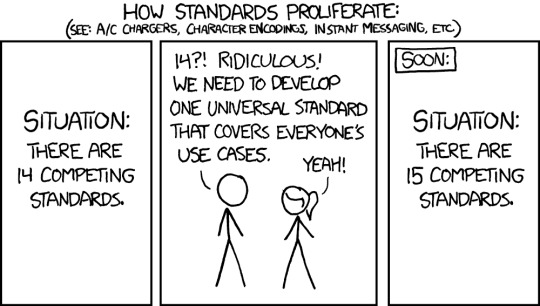
Source
[ID: XKCD comic that is titled "How Standards Proliferate (See: A/C chargers, character encodings, instant messaging, etc.)" It reads,
Situation: There are 14 competing standards. Cueball (stick figure): 14?! Ridiculous! We need to develop one universal standard that covers everyone's use cases. Ponytail (other stick figure): Yeah! Soon: Situation: There are 15 competing standards.
End ID]
(transcript taken from the ExplainXKCD wiki)
And of course, the students from countries on the Indian subcontinent are acutely aware of the unbalanced nature of the work they do, the way they’re expected to do export IT work, despite the digital divide in India, Bengal, Pakistan, etc. Especially since it’s a sign of being well-educated (wealthy) to speak English fluently thanks to the history of British Imperialism on the subcontinent.
Chinese IT students sink or swim thanks Mandarin monolinguism making it difficult to learn English. Americans programmers struggle not to link choppy English with choppy code, even while being monolingual themselves!
Not to mention the heavy sexism in the IT field! Female programmers taking on nicknames on emails and resumes to pretend to be men, so they’ll be taken seriously. Despite the history of women like Ada Lovelace being foundational to computers.
And of course we gotta bring up the ethics of AI, how it’s a march towards the inevitable that only Luddites would oppose. Despite the millions who’d lose their jobs once implemented into the workplace.
Commercial transportation sector lost to self-driving cars.
Digital artists lost to DALL-E.
Manufacturers automated.
But can’t they tell that progress is inevitable? That this is the future and to try to stop it is foolish?
As Anand Giridharadas put it in Winners Take All:
“In [Silicon] Valley, prediction has become a popular way of fighting for a particular future while claiming merely to be describing what has yet to occur”
Elon Musk is a genius. Bill Gates is so charitable. Bezos is customer obsessed, and they’re the future, don’t you see? Infinite growth forever and ever.
Tower of Babel? Valley of Silicon.
Unfortunately I suck at STEM, and I’m an uncultured Asian American, so I don’t know programming languages well, nor do I know enough about other cultures to do Ramy, Victoire, Robin, or Letty justice. Just the bare bones to see the structure of this AU and put it out in the world to see if anybody would like to play with it or add on.
#babel or the necessity of violence#babel#babel an arcane history#babel rf kuang#my thoughts#infinite growth is the silver#or maybe crypto as silver lol#Silicon Valley is babel#tech progress is our version of the inevitable empire#okay now this is the part in my notes where I ramble#Silicon Valley shined so bright but I feel like we’re reaching the point where it’s bloating everything#not everything can be solved by programming#AHEM NFTs are a nonsense solution made by tech bros to scam money under the illusion of useful technology#bc we want that infinite growth baby#I don’t hate AI but I do think the way it’s being implemented right now is unethical#and that said unethical-ness is being buried under the idea of ‘pragmatism’ or ‘progress’#the way a certain type STEM major considers feelings to be ‘irrational’ and therefore to be ignored#honestly that gives me repressed Robin vibes#I don’t actually think there’s anything wrong with there necessarily being a lingua franca for STEM fields#I get that it’s useful for international communication#but also it’s like a colonialist elephant in the room that could be explored through creative liberties
85 notes
·
View notes
Note
How is RPGmaker compared to Unity? Would you recommend it?
I think its difficult to compare RPGMaker to a lot of other game engines. Unity is pretty open ended in what you can make but you gotta know programming, whereas RPGMaker is kinda hard coded to make a very specific type of game very easily and without programming knowledge — the game in question being extremely generic retro JRPGs. If you wanna make something that extends beyond that you are gonna have to mess around a lot with plugins which alter and augment the preexisting structure the engine has in place.
The crazy thing is, RPGMaker (at least MV) is lacking MANY features that it by all means should have. My game doesn’t have a lot of mechanics and was designed around scope in a lot of ways, yet I am legitimately using 70 or so plugins that other people made to make it feel good. Some of those plugins’ functions include -Adding name plates over the characters’ text boxes -Making it so sprites don’t flash in and out when switching -Allowing for ANY kind of complexity in character animations -Giving you any sort of camera control -Hiding combat related UI in the menus. All of this being shit the engine SHOULD support by all means but for whatever reason it just doesn’t
I think if you’re someone who knows a lot about programming, the engine is probably gonna feel kinda bad and itd probably just be easier and less frustrating to build a lot of functionality from the ground up in an engine like Unity, GameMaker, or Godot. If you lack some experience and feel pretty confident that your game can reasonably fit within what the engine is capable of then RPGMaker is probably a good choice. And personally despite the lack of features being frustrating at times, I find myself having a lot of fun with the goofy wraparound method of problem solving you have to use and have found myself making some really cool creative decisions by working within the engine’s limits
It definitely helps a lot to know programming fundamentals either way (I’m not great but I have some experience with Java and C# and I feel like it’s been very helpful with managing project structure) so that’s something I’d recommend looking into either way if you’re not too acquainted
And I’ve mentioned it but again. Since RPGMaker is so limited you definitely DEFINITELY want to plan your project very heavily around scope especially if you don’t have much confidence that you can really delve into JavaScript programming. For example I wouldn’t recommend planning for complex UI - you will fuckin hate yourself for that. And if you’re adding combat you’re gonna wanna be super realistic about it. What I did to plan around scope was play ~10 different RPGMaker games sorta like what I wanted like to be before I started getting too many concrete ideas about what my game would look like so I could get a pretty solid idea of what was doable and mold my plans around that
Also I wanna point out - most tedious, large scope thing about my game is by far the character animations. Once I figured out just how itd work it wasn’t too bad but is still a bit annoying - but know I worked in a very very wraparound way that is way way way more involved than most — or hell, ANY RPGMaker games I’ve seen. It’s doable, can be really worth it if you’re willing to put in the time and effort, and is something I’d be happy to explain if anyone was interested. BUT i feel the need to make it clear that complex animation is very much not at all a baseline functionality of the engine since it might be easy to assume otherwise with how much it’s used in my own game
Apologies if that was long but I love talking about this stuff, and if anyone is interested I am always happy to talk about and answer any questions about my process especially with RPGMaker in mind :D
39 notes
·
View notes
Text
HAPPY NEW YEAR
I hope everyone reading this has a nice and calm year to look forward to. Good luck with your studies and keep pushing. You deserve the life you want. 💛
I have huge huge plans for 2023. The biggest one so far is finding a job at tech ! And moving ! I have a long way to go but it's completely doable which motivates me a lot.
I am on day 6 of 100 days of code! (To the people who recommended Notion for organization and note taking... I bow before you.)
I've been learning about object oriented programming and Selenium !
It's so interesting.

Also if anyone is wondering the "CodeBat" thingy you see above, it is a website that has basic java and python problems.
#100daysofcode#coding#codeblr#studyblr#code#java#python#self study#javascript#studyblr blog#notion#productivity
69 notes
·
View notes
Note
Prime numbers of the ask game let's go!
This is gonna be a long old post haha /pos
2. What math classes did you do best in?:
It's joint between Analysis in Many Variables (literally just Multivariable calculus, I don't know why they gave it a fancy name) and Complex Analysis. Both of which I got 90% in :))
3. What math classes did you like the most?
Out of the ones I've completely finished: complex analysis
Including the ones I'm taking at the moment:
Topology
5. Are there areas of math that you enjoy? What are they?
Yes! They are Topology and Analysis. Analysis was my favourite for a while but topology is even better! (I still like analysis just as much though, topology is just more). I also really like group theory and linear algebra
7. What do you like about math?
The abstractness is really nice. Like I adore how abstract things can be (which is why I really like topology, especially now we're moving onto the algebraic topology stuff). What's better is when the abstract stuff behaves in a satisfying way. Like the definition of homotopy just behaves so nicely with everything (so far) for example.
11. Tell me a funny math story.
A short one but I am not the best at arithmetic at times. During secondary school we had to do these tests every so often that tested out arithmetic and other common maths skills and during one I confidently wrote 8·3=18. I guess it's not all that funny but ¯\_(ツ)_/¯
13. Do you have any stories of Mathematical failure you’d like to share?
I guess the competition I recently took part in counts as a failure? It's supposed to be a similar difficulty to the Putnam and I'm not great at competition maths anyway. I got 1/60 so pretty bad. But it was still interesting to do and I think I'll try it again next year so not wholly a failure I think
17. Are there any great female Mathematicians (living or dead) you would give a shout-out to?
Emmy Noether is an obvious one but I don't you could understate how cool she is. I won't name my lecturers cause I don't want to be doxxed but I have a few who are really cool! One of them gave a cool talk about spectral geometry the other week!
19. How did you solve it?
A bit vague? Usually I try messing around with things that might work until one of them does work
23. Will P=NP? Why or why not?
Honestly I'm not really that well versed in this problem but from what I understand I sure hope not.
29. You’re at the club and Grigori Perlman brushes his gorgeous locks of hair to the side and then proves your girl’s conjecture. WYD?
✨polyamory✨
31. Can you share a math pickup line?
Are you a subset of a vector space of the form x+V? Because you're affine plane
37. Have you ever used math in a novel or entertaining way?
Hmm not that I can think of /lh
41. Which is better named? The Chicken McNugget theorem? Or the Hairy Ball theorem?
Hairy Ball Theorem
43. Did you ever fail a math class?
Not so far
47. Just how big is a big number?
At least 3 I'd say
53. Do you collect anything that is math-related?
Textbooks! I probably have between 20 and 30 at the moment! 5 of which are about topology :3
59. Can you reccomend any online resources for math?
The bright side of mathematics is a great YouTube channel! There is a lot of variety in material and the videos aren't too long so are a great way to get exposed to new topics
61. Does 6 really *deserve* to be called a perfect number? What the h*ck did it ever do?
I think it needs to apologise to 7 for mistakingly accusing it of eating 9
67. Do you have any math tatoos?
I don't have any tattoos at all /lh
71. 👀
A monad is a monoid in the category of endofunctors
73. Can you program? What languages do you know?
I used to be decent at using Java but I've not done for years so I'm very rusty. I also know very basic python
Thanks for the ask!!
7 notes
·
View notes
Text
How to Solve Programming Problems Using Data Structures

Introduction:
Are you a budding computer science enthusiast eager to crack the code of programming problems? If so, you're stepping into a world where challenges are aplenty, but so are the opportunities for growth and mastery. In this blog, we'll unravel the mysteries of solving programming problems with finesse by harnessing the power of data structures. Whether you're just starting out or aiming to refine your skills, these problem-solving strategies will be your trusty companions on your journey.
Let's Get Started:
Understanding Programming Problems:
Before plunging headfirst into solutions, it's essential to grasp the essence of the problem at hand. Read the problem statement meticulously, dissect its intricacies, and clarify any uncertainties before forging ahead.
Choosing the Right Data Structure:
Data structures act as the bedrock of efficient algorithms. Depending on the problem's nature, cherry-pick the most fitting data structure from an array of options like arrays, linked lists, stacks, queues, trees, or graphs.
Evaluating Time and Space Complexity:
Assessing the time and space complexity of your solution is akin to navigating through uncharted waters. Gauge the efficiency of different data structures and algorithms to ensure your solution sails smoothly, both in terms of time and memory.
Breaking Down the Problem: Break down the seemingly formidable problem into bite-sized chunks. This approach simplifies the problem-solving process, enabling you to tackle each fragment with clarity and precision.
Leveraging Problem-Solving Patterns:
Equip yourself with a repertoire of problem-solving patterns such as brute force, greedy algorithms, divide and conquer, dynamic programming, and backtracking. Recognizing these patterns acts as a compass, guiding you towards crafting ingenious solutions.
Embracing Practice:
Just as a skilled artisan hones their craft through practice, so too does a proficient programmer. Dedicate time to solve a diverse array of programming problems regularly. This not only sharpens your problem-solving acumen but also acquaints you with a myriad of data structures and algorithms.
Tapping into Guidance and Resources:
In the vast landscape of programming, seeking guidance and resources is akin to discovering hidden treasures. Engage with online communities, peruse through forums, and collaborate with peers. Additionally, consider enrolling in online courses or training centres to delve deeper into the realm of data structures and problem-solving techniques.
Testing Your Mettle:
Put your solutions through the crucible of rigorous testing. Experiment with sample test cases, explore edge scenarios, and confront corner cases head-on. Verify that your code behaves as expected and pre-emptively address any lurking errors or anomalies.
Iterating and Refining:
Iteration is the crucible where brilliance is forged. Continuously refine your solutions, refactor your code, and explore alternative avenues. Strive for elegance, efficiency, and readability in your codebase.
Embracing Persistence and Patience:
Embarking on the odyssey of solving programming problems demands unwavering persistence and patience. Embrace the challenges, surmount the hurdles, and maintain a steadfast resolve. With each problem conquered, you inch closer towards mastery.
In Conclusion: Embarking on the journey of mastering programming problems with data structures is akin to embarking on a grand adventure. Armed with a systematic approach, a thirst for knowledge, and a dash of perseverance, you're well-equipped to navigate the labyrinthine realm of coding challenges. Remember, every problem solved is a testament to your growth and evolution as a proficient programmer. So, roll up your sleeves, dive into the fray, and let the quest for mastery commence!
Suggested Blogs:
Java Programming
Core Java Fundamentals
Algorithms and Data Structures
0 notes
Text
Learn something new in 2024!

Learn how to code in 2024 with @Study Hall’s Code and Programming for Beginners course! Master the fundamentals of programming and earn college credit while you build java programs to solve real-world problems.
Check out the course videos for free on YouTube, then join the online college course led by ASU faculty for just $25 and apply what you’ve learned. If at the end of the course you’re happy with your grade, pay an optional fee and add 3 transferable credits to your transcript!
Next course starts Jan 9th, join the coding cohort at https://link.gostudyhall.com/ccj

41 notes
·
View notes
Text
Fibonacci three ways (in Haskell)
I thought I'd start posting some fun programming exercises to show off the programming language Haskell, for anyone who hasn't seen it.
The Fibonacci sequence is famous, if you've done any coding or have any interest in math you've surely seen it. If you haven't seen it before, a number in the Fibonacci sequence is the sum of the previous two numbers. So, the sequence goes: 1, 1, 2, 3, 5, 8, etc.
A straightforward recursive definition can be written out directly from this definition:

Of course this is pretty inefficient, as you've seen if you've talked about Fibonacci in an algorithms class. Think about how much repeated work happens; if you want to calculate the 20th Fibonacci number, for example, how many times do you end up calculating the 10th number?
In traditional imperative languages like C/Python/Java/etc, we'd instead do this calculation with a for loop. Haskell doesn't have those (pure functions only), but that's no problem! We can take the same loop we'd write in Python and express it as a tail-recursive function.

Okay, so what? Well, this version is significantly more efficient, because it doesn't duplicate all the work like the first one did.
But this isn't too interesting. We could have just written all of this in Python or whatever. What's so special about Haskell?
Well, here's a third way we can compute the Fibonacci sequence in Haskell:

This defines an infinite list containing all the Fibonacci numbers, then plucks the nth number out of that list. Notice how fibs refers to itself! It's a recursive definition! No wasted work. In fact, Haskell is smart enough to not actually try to compute the whole infinite list (that would be an infinite loop, obviously), but only compute enough of the list to give us the answer we want.
110 notes
·
View notes
Text
The Roadmap to Full Stack Developer Proficiency: A Comprehensive Guide
Embarking on the journey to becoming a full stack developer is an exhilarating endeavor filled with growth and challenges. Whether you're taking your first steps or seeking to elevate your skills, understanding the path ahead is crucial. In this detailed roadmap, we'll outline the stages of mastering full stack development, exploring essential milestones, competencies, and strategies to guide you through this enriching career journey.

Beginning the Journey: Novice Phase (0-6 Months)
As a novice, you're entering the realm of programming with a fresh perspective and eagerness to learn. This initial phase sets the groundwork for your progression as a full stack developer.
Grasping Programming Fundamentals:
Your journey commences with grasping the foundational elements of programming languages like HTML, CSS, and JavaScript. These are the cornerstone of web development and are essential for crafting dynamic and interactive web applications.
Familiarizing with Basic Data Structures and Algorithms:
To develop proficiency in programming, understanding fundamental data structures such as arrays, objects, and linked lists, along with algorithms like sorting and searching, is imperative. These concepts form the backbone of problem-solving in software development.
Exploring Essential Web Development Concepts:
During this phase, you'll delve into crucial web development concepts like client-server architecture, HTTP protocol, and the Document Object Model (DOM). Acquiring insights into the underlying mechanisms of web applications lays a strong foundation for tackling more intricate projects.
Advancing Forward: Intermediate Stage (6 Months - 2 Years)
As you progress beyond the basics, you'll transition into the intermediate stage, where you'll deepen your understanding and skills across various facets of full stack development.
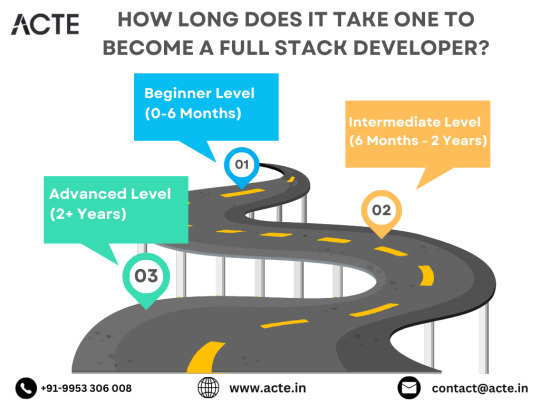
Venturing into Backend Development:
In the intermediate stage, you'll venture into backend development, honing your proficiency in server-side languages like Node.js, Python, or Java. Here, you'll learn to construct robust server-side applications, manage data storage and retrieval, and implement authentication and authorization mechanisms.
Mastering Database Management:
A pivotal aspect of backend development is comprehending databases. You'll delve into relational databases like MySQL and PostgreSQL, as well as NoSQL databases like MongoDB. Proficiency in database management systems and design principles enables the creation of scalable and efficient applications.
Exploring Frontend Frameworks and Libraries:
In addition to backend development, you'll deepen your expertise in frontend technologies. You'll explore prominent frameworks and libraries such as React, Angular, or Vue.js, streamlining the creation of interactive and responsive user interfaces.
Learning Version Control with Git:
Version control is indispensable for collaborative software development. During this phase, you'll familiarize yourself with Git, a distributed version control system, to manage your codebase, track changes, and collaborate effectively with fellow developers.
Achieving Mastery: Advanced Phase (2+ Years)
As you ascend in your journey, you'll enter the advanced phase of full stack development, where you'll refine your skills, tackle intricate challenges, and delve into specialized domains of interest.
Designing Scalable Systems:
In the advanced stage, focus shifts to designing scalable systems capable of managing substantial volumes of traffic and data. You'll explore design patterns, scalability methodologies, and cloud computing platforms like AWS, Azure, or Google Cloud.
Embracing DevOps Practices:
DevOps practices play a pivotal role in contemporary software development. You'll delve into continuous integration and continuous deployment (CI/CD) pipelines, infrastructure as code (IaC), and containerization technologies such as Docker and Kubernetes.
Specializing in Niche Areas:
With experience, you may opt to specialize in specific domains of full stack development, whether it's frontend or backend development, mobile app development, or DevOps. Specialization enables you to deepen your expertise and pursue career avenues aligned with your passions and strengths.
Conclusion:
Becoming a proficient full stack developer is a transformative journey that demands dedication, resilience, and perpetual learning. By following the roadmap outlined in this guide and maintaining a curious and adaptable mindset, you'll navigate the complexities and opportunities inherent in the realm of full stack development. Remember, mastery isn't merely about acquiring technical skills but also about fostering collaboration, embracing innovation, and contributing meaningfully to the ever-evolving landscape of technology.
#full stack developer#education#information#full stack web development#front end development#frameworks#web development#backend#full stack developer course#technology
6 notes
·
View notes